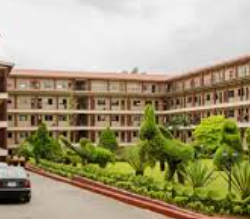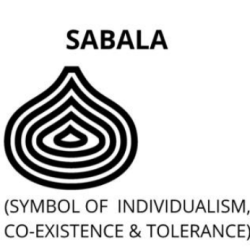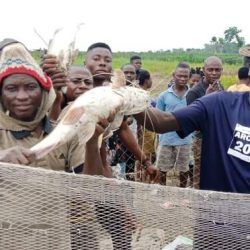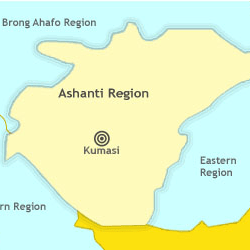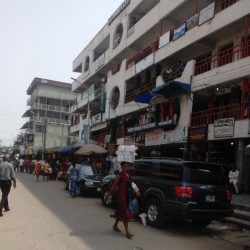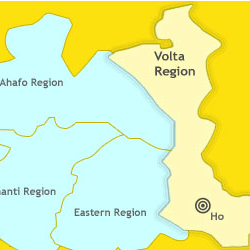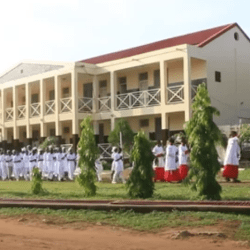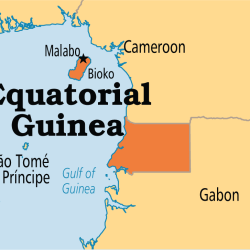Origin
The Adinkra symbols are believed to have their origin from Gyaman, a former kingdom in today’s Côte D’Ivoire.
According to an Asante (Ghana) legend Adinkra was the name of a king of the Gyaman (Nana kofi Adinkra). Adinkra was defeated and captured in a battle by the Asantes for having copied the “Golden Stool”, which represents for them absolute power and tribal cohesion. He was finally killed and his territory annexed to the kingdom of Asante.

The tradition had it that Nana Adinkra wore patterned cloth, which was interpreted as a way of expressing his sorrow on being taken to Kumasi the capital of Asante. The Asante people around the 19th century then took to painting of traditional symbols of the Gyamans onto cloth, a tradition that was well practiced by the latter.
Adinkra also means ‘goodbye’ or ‘farewell’ in Twi the language of the Akan ethnic group of which Asante is a part. It has therefore been the tradition of the Akan especially the Asante to wear cloths decorated with Adinkra symbols on important occasions especially at funerals of family relations and friends. This is to signify their sorrow and to bid farewell to the deceased.
Today, the Adinkra cloth is not exclusively worn by the Asante people. It is worn by other ethnic groups in Ghana on a variety of social gatherings and festive occasions
Symbolism/Significance
The Adinkra symbols express various themes that relate to the history, beliefs and philosophy of the Asante. They mostly have rich proverbial meaning since proverbs play an important role in the Asante culture. The use of Proverbs is considered as a mark of wisdom.
Other Adinkra symbols depict historical events, human behaviour and attitudes, animal behaviour, plant life forms and shapes of objects. 2 In fact, the Adinkra symbols continue to change as new influences impact on Ghanaian culture as some of the symbols now record specific technological developments.
The Adinkra cloth is stamped or printed with Adinkra symbols. It is one of the few examples of traditional cloths in Africa.
The Adinkra cloth was hitherto the preserve of the royalty and spiritual leaders of the Asantes. They wore it during very important sacred ceremonies.
Today the Adinkra cloth is used for a wide range of social activities such as festivals, marriage, and naming ceremonies among others.
Types
The 3 most important funerary Adinkra are the dark – brown (kuntunkuni) the brick – red (kobene) and the black (brisi). There are however, other forms of which cannot be properly called mourning cloth. Their bright and light backgrounds classify them as 3 Kwasiada Adinkra or Sunday Adinkra meaning fancy cloths which cannot be suitable for funerary contents but appropriate for most festive occasions or even daily wear.
Other uses of the Adinkra symbols
Adinkra symbols can be described as small, symbolic pictures or motives used to decorate colourful patterned cloth by fashion designers in Ghana.
Designers in modern times use Adinkra symbols in creating and decorating other accessories than cloth.
Other artisans/crafts men such as sculptors, carpenters, and architects also use the symbols to design their products.
Some corporate institutions in Ghana now use the Adinkra symbols as their institutional Symbol or Logo.
Adinkra Printing
The Asante people have developed their unique art of adinkra printing. They use two traditional printing methods; the block-stamp technique, which involves the use of wooden or metal stamps and the screen-printing.

The Adinkra cloth was originally printed from hand carverd stamps from calabash or gourd (apakyiwa). The dye or ink (adinkra aduru) for printing is derived from the bark of the Badie and the roots of the kuntunkuni trees.
The bark and roots are soaked in water for days to soften. They are then pounded to increase the softening process. The 4 Badie bark is boiled with iron scraps. When the colour (deep brown) emerges from the pulp it is sieved and engraved onto a piece of calabash or pot.

The kuntunkuni roots are also boiled into a dark solution to dye the cloth black. The Cloth is dipped and soaked in the solution. It has to be dried several times before it turns completely black.

The cloth is normally dyed in either red or black. For the red Adinkra cloth, a chemical called Sudi is used instead of the kuntunkuni root.
The Stamps
The various stamps carved from the calabash are tinted with dye and pressed in sequence onto plain cotton cloth, pegged on the ground. Today raised platforms with sack covering act as the printing table. 5 In recent times imported cloth is used as the background of the cloth.
Sometimes the various symbols are used on one fabric and this also has its significance. The designing is done according to the message the wearer or owner of the cloth intends to convey to the participants of the event. The quality of the cloth also shows the status of the one wearing it.
The original Adinkra cloth is not meant to be washed since it faded easily as a result of the natural ink used without any chemical additives. Today, other types of cloth are used with the same adinkra motives but stamped in indelible colours using the batik method. Ntonso, a town in the Ashanti Region is noted for Adinkra cloth production. It is popularly acknowledged as the “Home of Adinkra”
Aesthetic value
The several bright colours of red, yellow, white, blue etc. of the Kwasiada Adinkra project the festive nature of the day. Sundays are normally characterized by drumming and dancing, playing of “owari” and “dame” (traditional games and other exciting social and religious activities. In contrast to the above is the dark and dull colours of black, dark – brown and brick red which are the make-up of the “Birisi”, “Kuntunkuni” and “Kobene” cloths.
Black for instance among the Asantes evokes an aesthetic response of sadness and hopelessness, The red colour is normally associated with blood and death. That is why during funerals Kobene in particular is worn by the closest relatives to show how aggrieved they were and the others appear in different cloths Kobene is also worn during the Asantehene’s funeral or when there is a national calamity. The Omanhene of Abeadze of Domenase said the cloth means “our eyes are red”. 6 Below is a table displaying in alphabetical order some of the old and new Adinkra and other cultural symbols of the Akan.
They have been arranged by names in Twi, literal translation in English, significance and proverbial meaning where available.



















References:
Abissath, M. K. & Korem, A. K. TRADITIONAL WISDOM IN AFRICAN PROVERBS, 1915 Proverbs from 41 African Countries, Publishing Trends Ltd. Accra 2004.
Arthur Kojo, G. F. & Rowe R., Akan Adinkra cloths, Akan Cultural Symbols Project, 1998-2001, http://www.marshall.edu/akanart
Glover, A. (Prof.), Adinkra symbolism, Artiste Alliance Gallery, Omanye House, Accra. Ghana. 1992.
Strenna Per Gli Amici, Adinkra, Massimo Baistrocchi, Italy .2003/2004.
Adinka, http://www.ghana.gov.gh/visitng/culture/adinkra.php
Asante Adinkra Cloth, Adire African Textiles, http://www.adireafricantextiles.com
Facts and History, Adinkra Symbols, http://www.ghanatourism.gov.gh Adinkra Symbols of West Africa, West African Wisdom: Adinkra Symbols and meanings, Adinkra Index, http://www.weltempered.net/adinkra/htmls/adinkra_indexhtm
Adinkra Symbols: A Philosophical writing System, Cornell University, http://www.library.cornell.edu/africana/Writing_Systems/Adinkra_pag e2.html26
Adinkra symbols, http://www.altreligion.about.com/libray/glossary/symbols/bldefsadinkra.htm Adinkra at Ntonso, The Mirror, 22 April 2006, Page 32.
Compiled by: Valentina A. Tetteh, NCC


